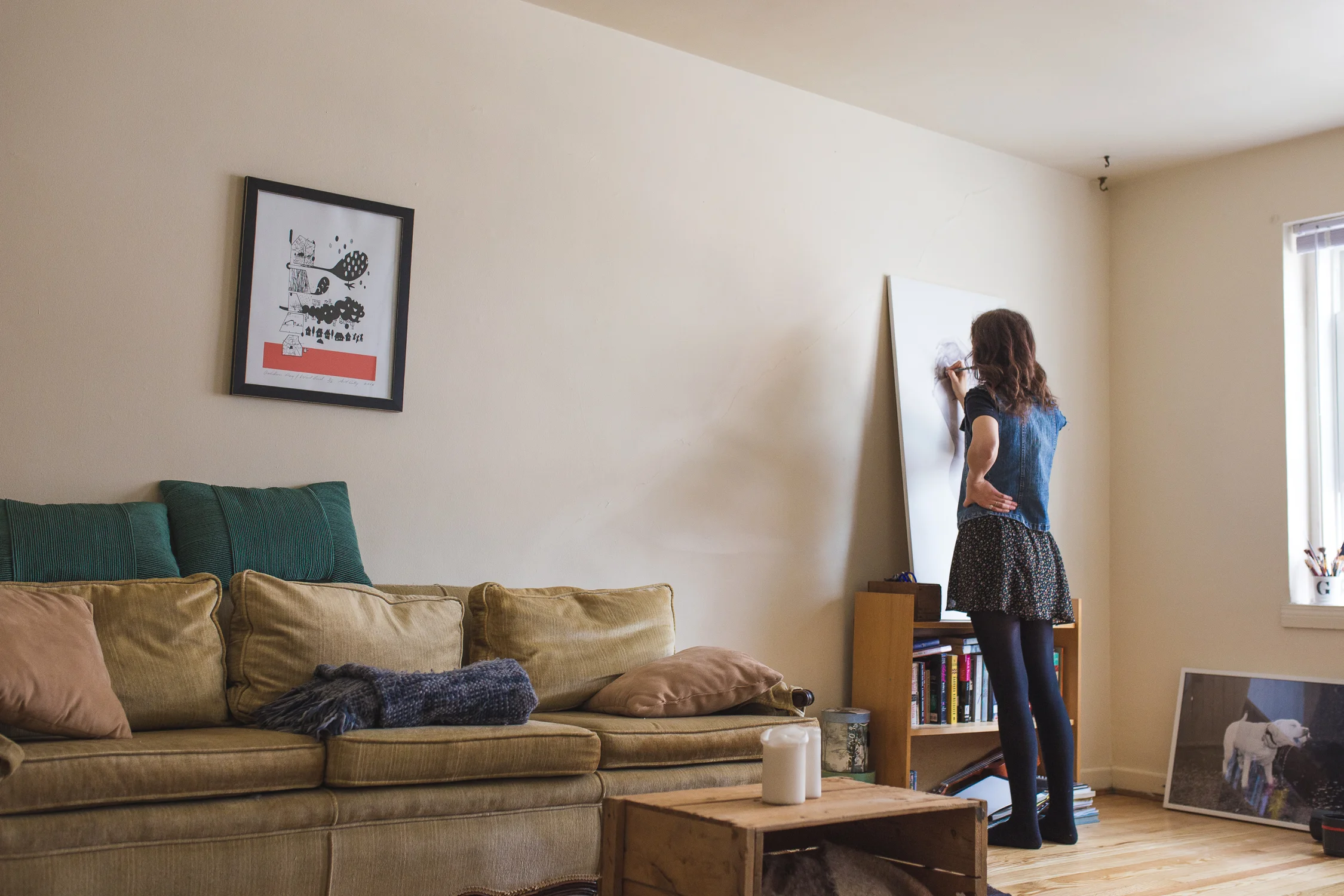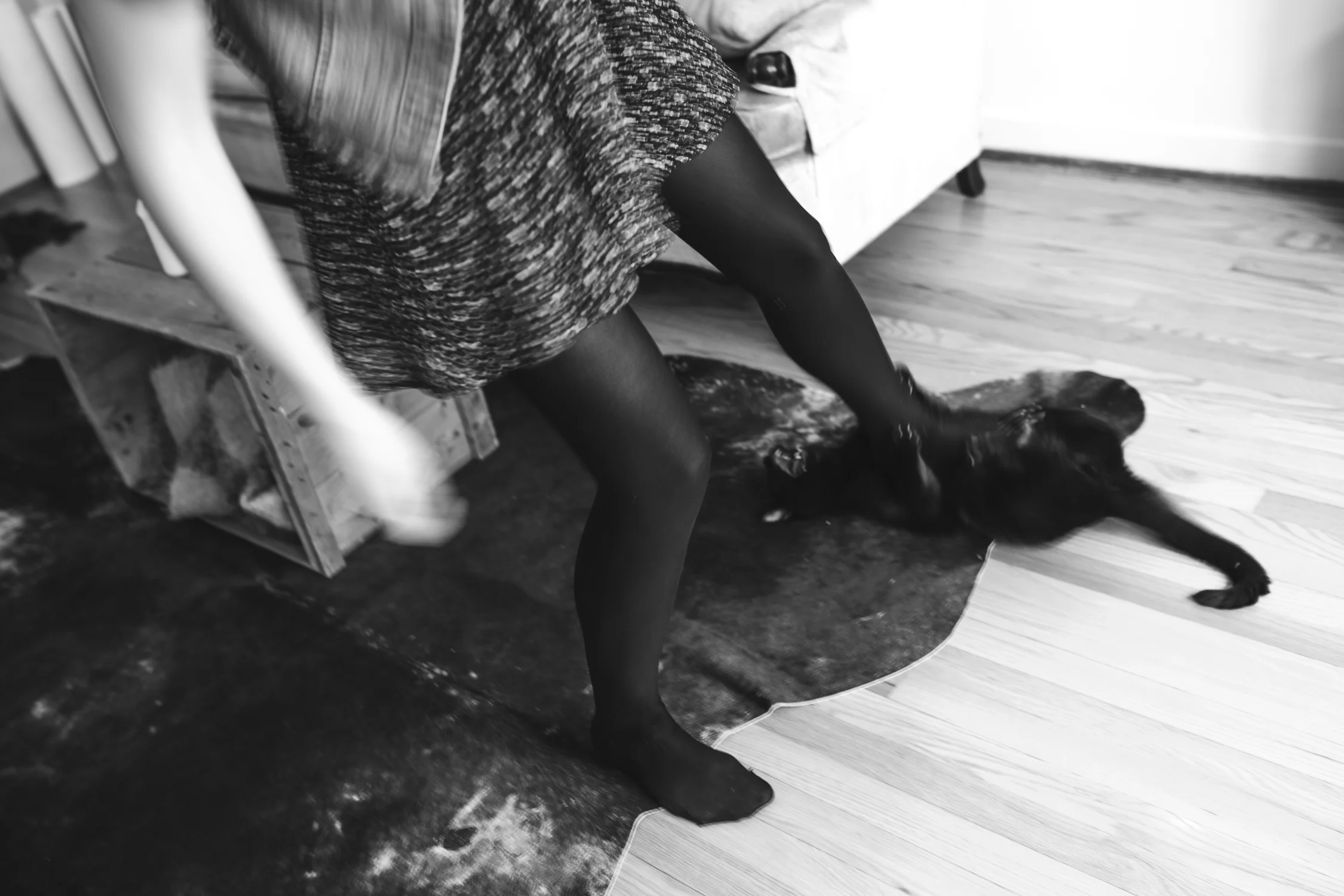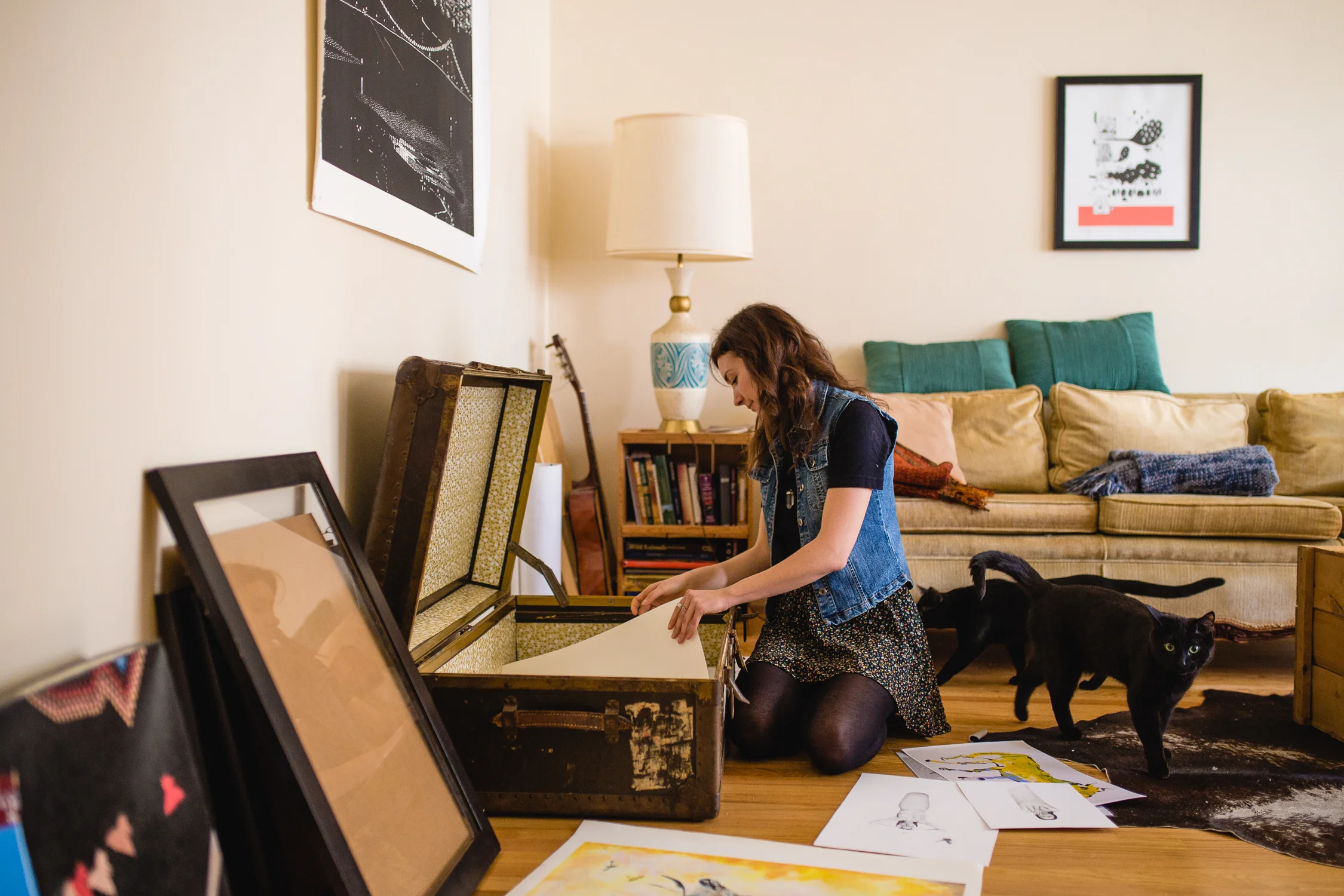Gabrielle Funk: Psychopomp at Gurevich Fine Art
It’s late March, one week prior to the opening of Gabrielle Funk’s show Psychopomp at Gurevich Fine Art, when I climb the stairs to her new apartment on Assinaboine. Gabrielle’s spent more than a hundred hours making points over the last two weeks.
Her breathtaking pointillist self-portraits feature human figures and animals, born out from what she calls an “obsessive” practice.
The concept for the show has, according to Gabrielle, “come to fruition over the last few months.” Originally, she had planed a more conceptual, structured show based on a book she read this past fall. But after a recent parting-of-ways with her partner and the studio space they shared in their home, the show took a different direction. Psychopomp “emerged in a very natural way out of a pretty raw, transitional emotional state,” Gabrielle says. Each piece serves as “a sort of spiritual identity” simultaneously representing Gabrielle herself as well as a kind of spiritual guide through a state of transition “from one self to another.”
Gabrielle busies herself, making tea, adding more detail to the last self-portrait to join the show, pulling old work from an antique trunk, shooing her cats away from me and my allergic nose. We sit down to talk more about her work.
FULL: What do you feel you’re communicating about transition through Psychopomp?
Gabrielle Funk: I want to give a sense of acceptance of change, and reveal the little tensions that exist through a transitional phase. Many times in life, you can easily define the change from one thing to another, but it’s such a complicated thing to evolve as a human. There are moments when you look back and go, “Wow, I don’t know when it happened, but I don’t have quite the same opinion as I did before, or I see myself differently than I used to.” There are times where you can clearly see how and why you are different because of something significant you've witnessed or experienced, but there are subtler changes too. Each piece in Psychopomp represents those graceful moments of transition that you almost don’t even feel -- the kind that happen all the time.
FULL: I’m curious about the significance of animals for you. The combination of human figures and animals is something I see a lot in your work.
GF: I painted and drew animals as a way to practice techniques and experiment with aesthetics. When I first started to make work, I didn’t necessarily want to take a strong stance on any social issue, as is more the case when I render nude human bodies. I started exploring the idea that animals can act as a blank slate for people to draw whatever meaning they want. They’re deeply meaningful and symbolic in so many cultures and contexts. Gradually, certain animals have developed a have strong representation in my own life. For this show, the animals are dogs, crows, and horses.
FULL: What do those animals represent to you symbolically?
GF: The title of this show, Psychopomp, loosely translates to “the guide of souls.” They are mystical characters that come up in all sorts of myths whether they be contemporary or ancient, secular or religious. Often they appear in funerary art. These animal guides essentially symbolize death -- they bring a spirit from one life and safely guide their transition to whatever afterlife they will inhabit. Dogs, horses and crows are historically, and across different cultures, common representations of that.
FULL: How did you come to combine animals with humans in your work?
GF: At the very fledgling stages of wanting to seriously make art, I was inspired by Alexander McQueen. He created this fashion line called Savage Beauty, where he made clothing that resembled ornate sculptural works built out of natural objects, and the bones and fur of animals. The first drawing I ever made that depicted a human/animal combination was inspired by that.
I’ve come to identify with animals as a symbolic emotional vessel. As I said, in many cultures people personify animals and put so much meaning into them. I started off playing with them aesthetically, and just realized there’s so much to explore. They can be a strong symbolic tool.
FULL: In your work, do you query why it is that humans are so drawn to animals?
GF: I know for me there’s something very pure about an animal. They’re an instinctual being that seems to have its purpose set out before it begins. There’s a simplicity and loveliness to that. Humans have a way of complicating everything for themselves and animals as well. Sometimes I think there must be a kind of envy or a memory of being wild and instinct-driven. We have lizard brains that still function and guide us in the most crucial moments. These old flight-or-fight responses are still there for us, but have a way of ruining things sometimes, because we don’t need them to the level that we did.
It’s funny what we have done with domestic animals, putting them into our human-made spaces and watching how they interact with that. I think can be pretty negative a lot of the time.
I started using dogs in my art after a residency in Mexico last year. Dogs are such a symbol of domestication and friendship. There's an idea that there’s a mutual give and take with the owner and pet, but in Mexico, there are packs of stray dogs that are kind of domesticated, but still quite wild and generally uncared for. Those strays were a version of a very familiar animal that I hadn’t really encountered until then.
FULL: What got you into pointillism?
GF: It started as a way of trying to create gradient and shading using ink. Originally, when I would draw with pen, I would mark out the shape of whatever the shading or shadow was, and then fill it with these really tiny lines. The figure would look like a map almost. Then I wanted to develop more control, so I started using these little ticks as well. And slowly those ticks became dots and the lines disappeared altogether. With every single piece, it’s gotten more detailed and obsessive.
I’ve started to think that each point is a decision, and I really like the idea that at the end of it, when you see the piece really close, there are thousands and thousands of individual decisions that are visible and separate. I also feel the dots resemble cells when you get close. Each image is made up of hundreds and hundreds of tiny points when you look closely enough, but there's space between each one. It is like in our own bodies, there are tiny spaces between each one of our cells.
FULL: You mentioned the word obsessive. Tell me more about how obsession is part of your process as an artist.
GF: Well, the last two days I’ve spent drawing the butt on this last portrait. I’m not kidding, I spent sixteen hours doing the shading on the butt. It looks almost exactly the same as it did two days ago, but slowly these layers build up. To create the texture of skin, I’ve realised how endless the actual variation is. There are so many different subtle changes in the texture and colour, and if it’s monochrome, to represent that is even more difficult. When I’m working, I have to tap into this level of observation where I’m like, “What are you missing? What are you not seeing on this skin?” And so what I’ve come to realise is that there’s a point where, probably here, or maybe even ten steps back from where this piece is, anyone else looking at it, would be like, “This looks like a finished piece. This looks just like a body.” But if I can continue to push into it and strive for greater and greater realism, details emerge, in a body or an animal, that you just don’t notice the impact of until you put them there, and then you realise how significant they are to bringing something to life.
I think that’s why I’m so obsessive, because I want to figure out how to represent these tiny details in a way that makes people see them.
FULL: What you’re doing is simultaneously incredibly repetitive, but also, when you talk about each point being a decision, it requires a high level of attention.
GF: I’ve definitely learned a certain level of patience, but also I’m starting to wonder what it does to my mind when I go into this state. Since I’ve moved into this apartment, it’s going on 100 or more hours of drawing, and I’ve only been here for two and half weeks. I know that because I’m listening to podcasts and can gage the time. I wonder what happens to your brain when you spend this much time doing a repetitive task; even with the larger goal in mind, it is still a repetitive task to the most extreme degree.
FULL: You’ve already mentioned that the pieces for this show are all self-portraits. Another thing I notice about your work is how isolated your figures tend to be. What role do isolation and the self play in your work?
GF: I’ve thought a lot about this too. Why am I making images of myself and why are they alone? There’s something about the subtlety of a single expression. All my work goes into the rendering of this one expression, and it’s very vulnerable. I’m still figuring out why that is important to me. Because it is very self-indulgent, and I almost have a problem with that at certain moments.
FULL: Do you think that the universal is in the personal though?
GF: Yeah, especially after the experience of creating this show. I know the images are of me, but it feels like more than that. Especially when you think about the the female figure. This is not new to art, doing, first of all, self-portraiture, and second of all, rendering nude female figures. But it’s an important and self-empowering thing for me to create an image of myself and have complete ownership over how that image is portrayed. With each portrait, I get one chance to make a gesture at the viewer. I simultaneously want them to be aggressive and sexual and shy, to encapsulate as many different things in one as I can.
Some of them have imperfections that are very obvious when compared to the Western standard of beauty -- belly rolls, stretch marks, or an awkward pose looking kind of defeated. The facial expression may be kind of unpleasant. I would like them to be beautiful, but not traditionally beautiful. I want to express something that is totally authentic and not really apologetic, but there is an apology in some of them too. I don’t want to pretend that some sense of shame or wanting abide by a beauty standard doesn’t exist in me, because I was raised in this culture. The figures kind of grapple with almost posing and trying to look a certain way, like trying to be sexy, but some become a parody of that.
I didn’t know how to express what I wanted from my viewer until I had this experience at a past show where a man wanted to purchase a piece, but he didn’t feel right about wanting to buy it, and he wanted to have a conversation about that. What he didn’t say explicitly, but what I got from the conversation, was that that he thought it was sexy, but he felt weird about thinking it was sexy. Essentially he wanted me to justify for him why it was okay that he thought it was sexy, and explain away his sense of doubt about it.
I couldn’t do that for him, because the doubt is the point. You had an initial animal sexual impulse toward a nude body on a wall that’s begging to be looked at because it’s in a frame in a gallery, but you questioned it because something about the subject pointed a finger at you or asked a question of you, and made you feel wrong somehow for wanting the object to just be an object.
He didn’t end up buying the piece. And I was like, “That’s exactly what I want every time.” That recognition of sexuality, but not being able to just take it for yourself. It creates a pause.









